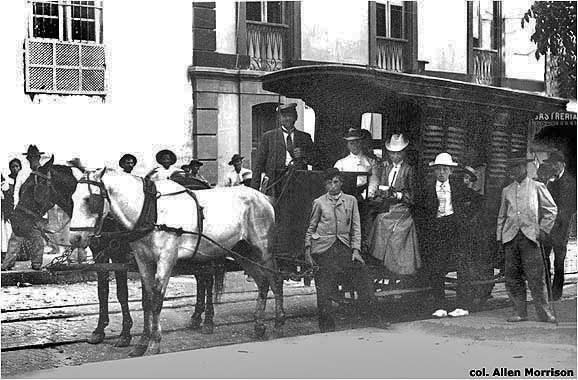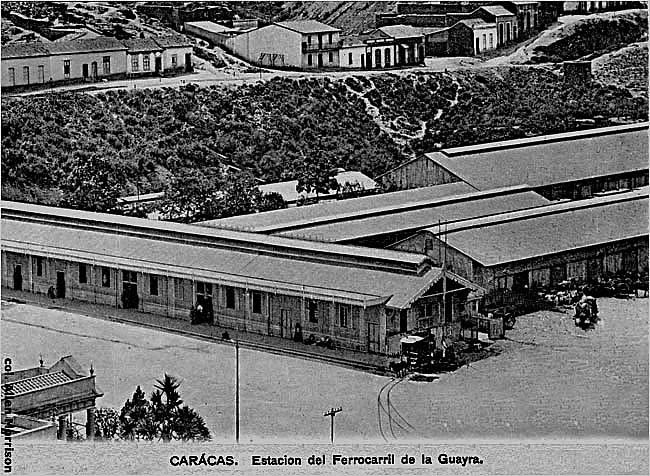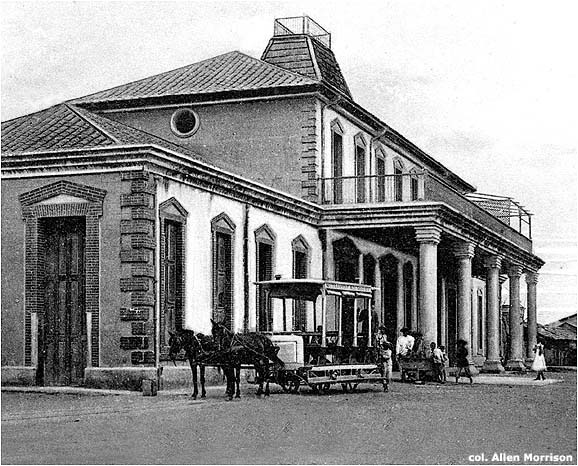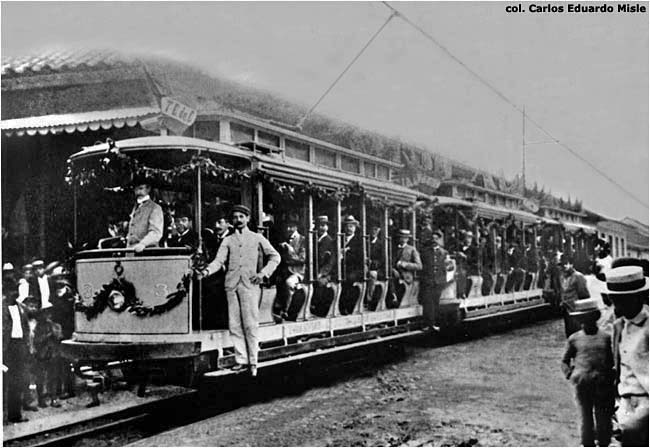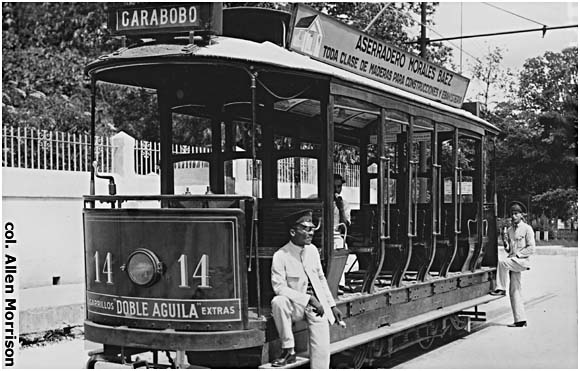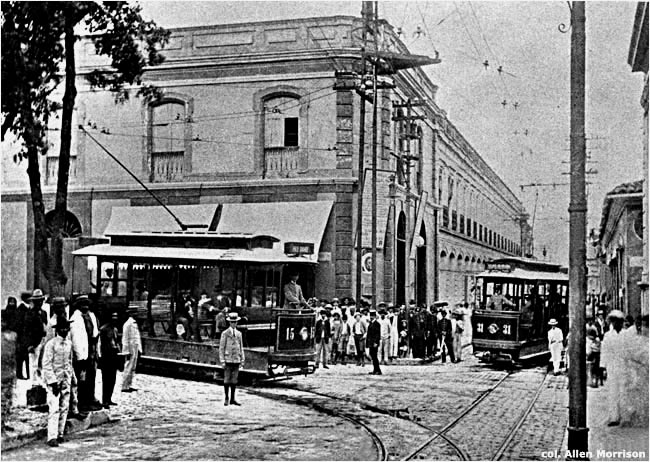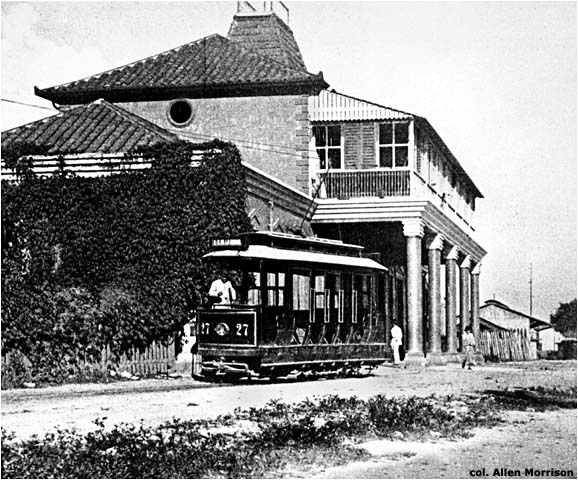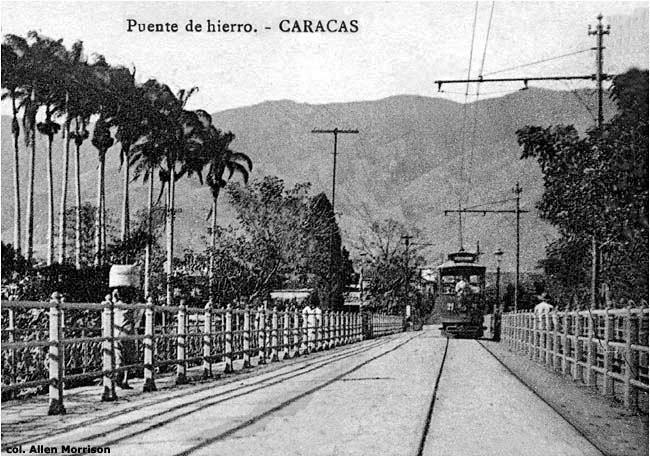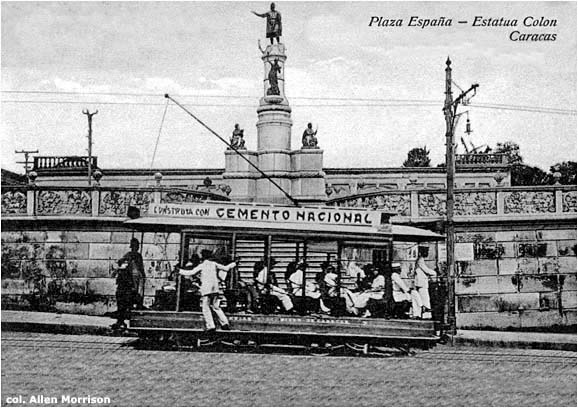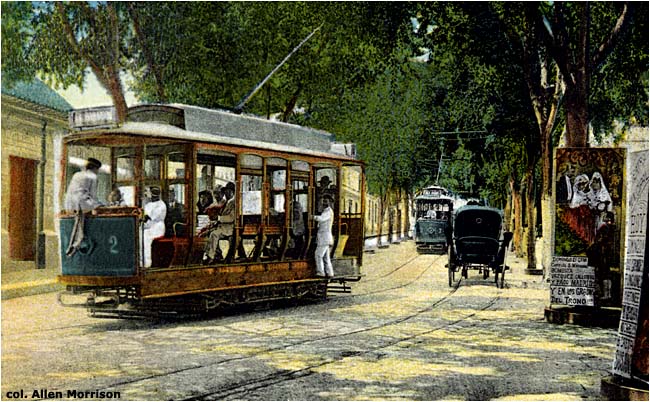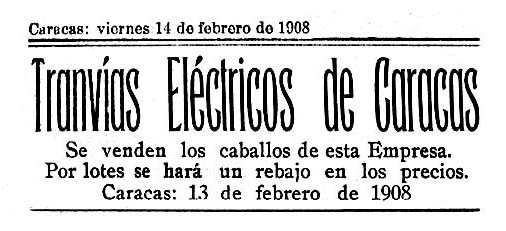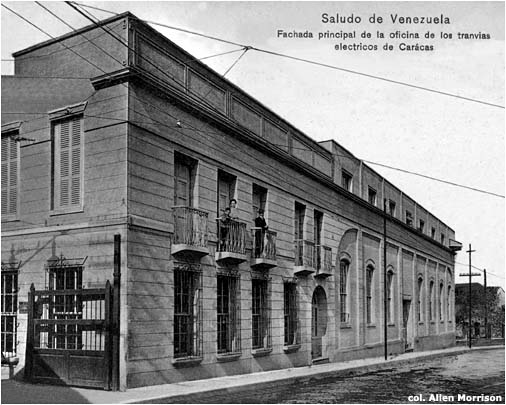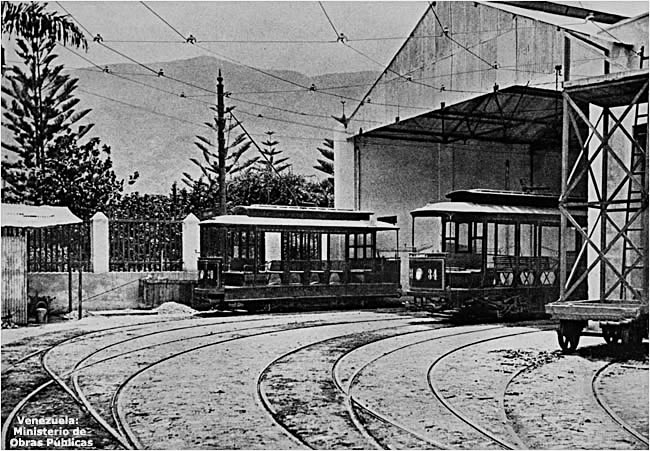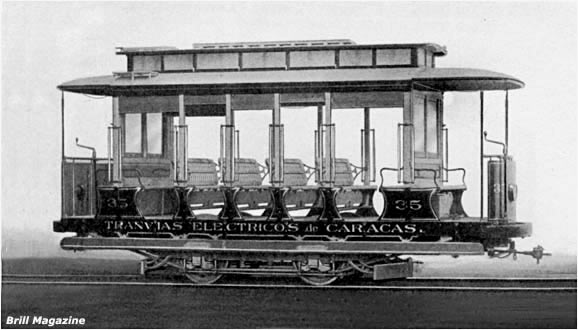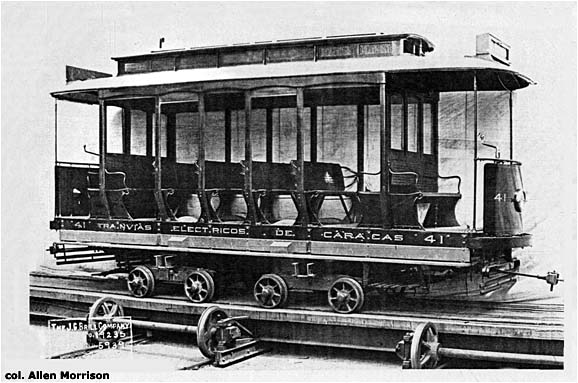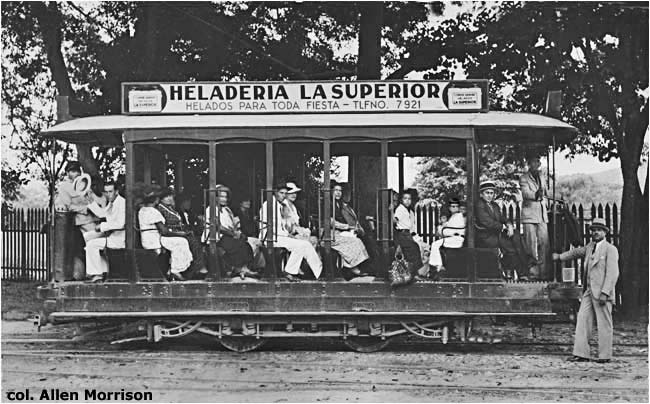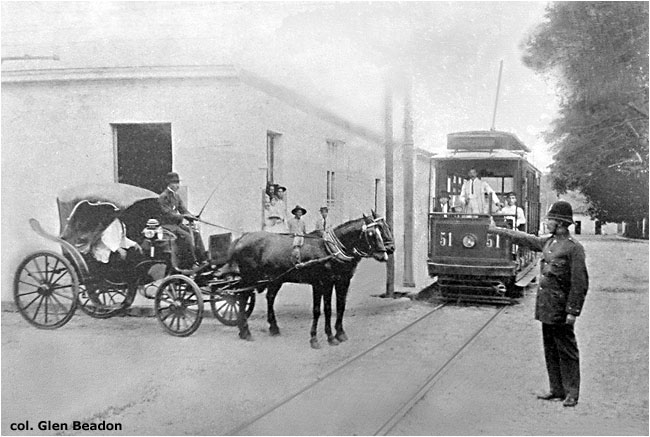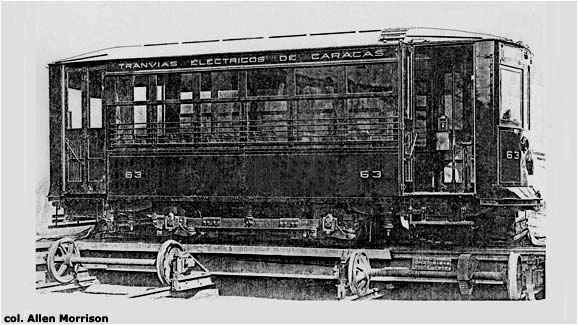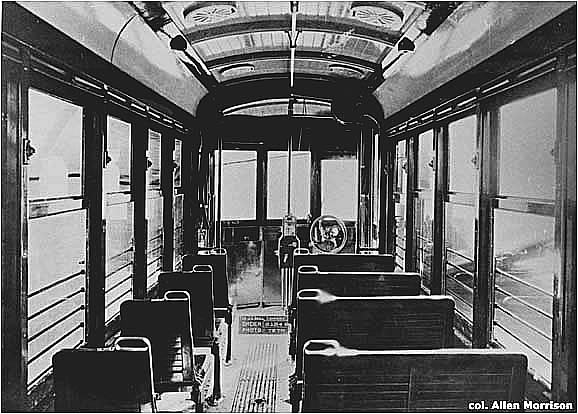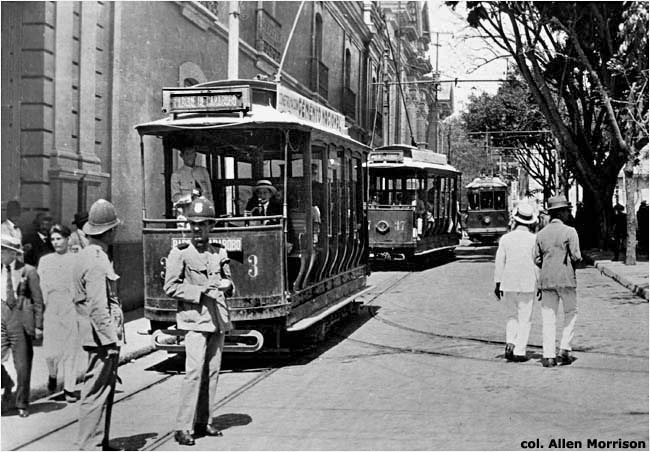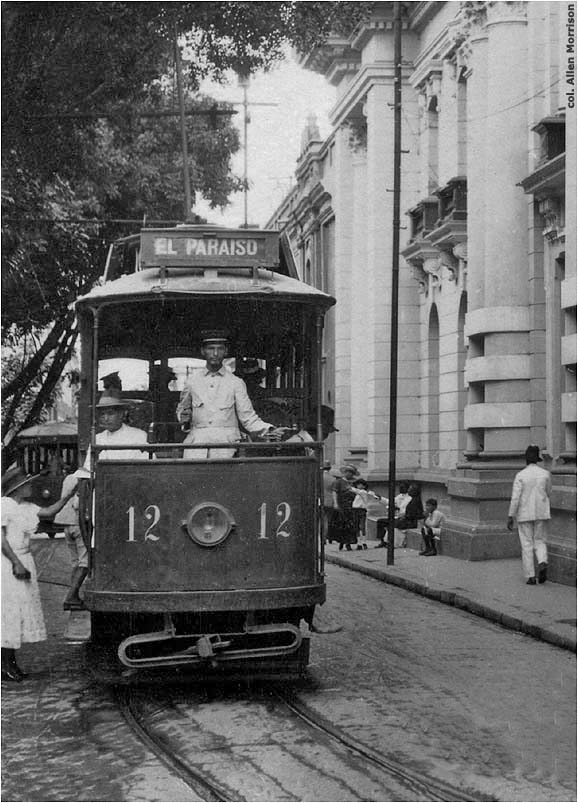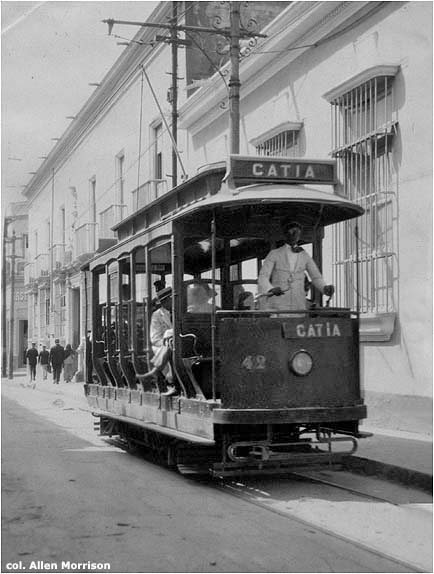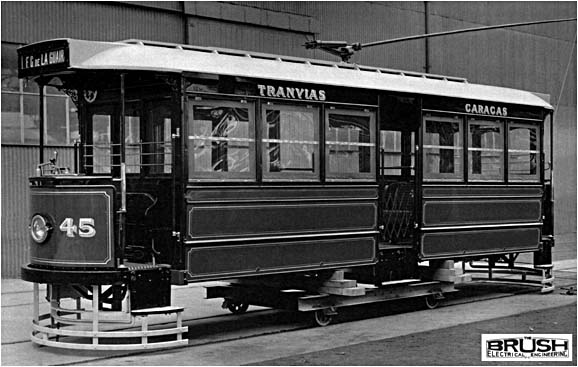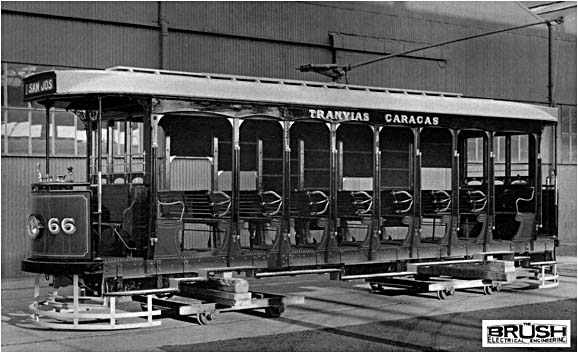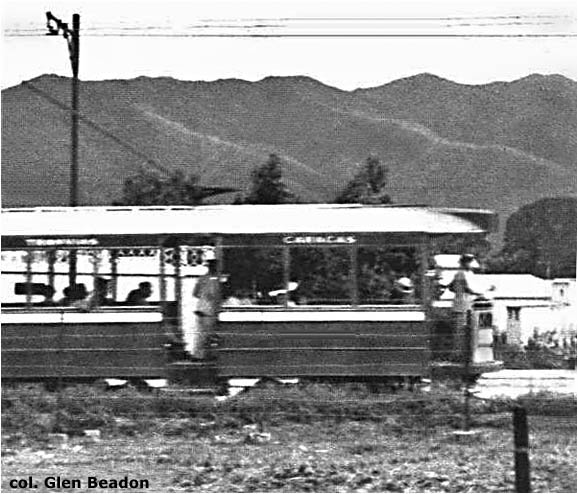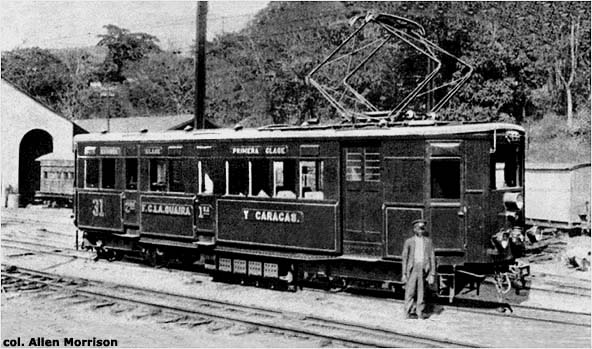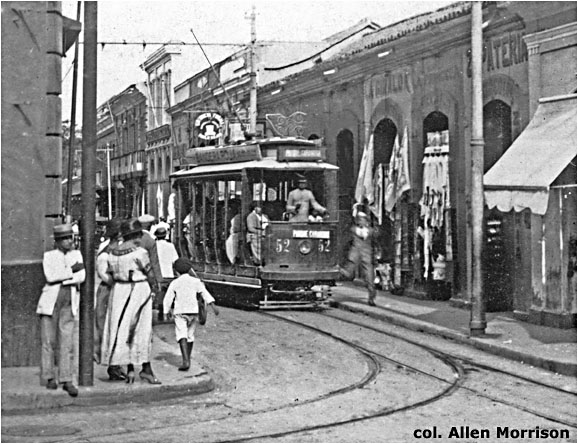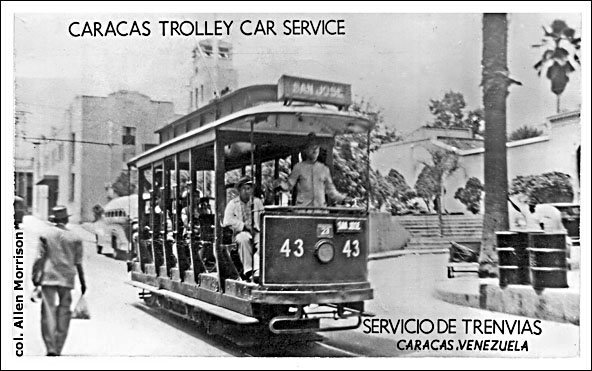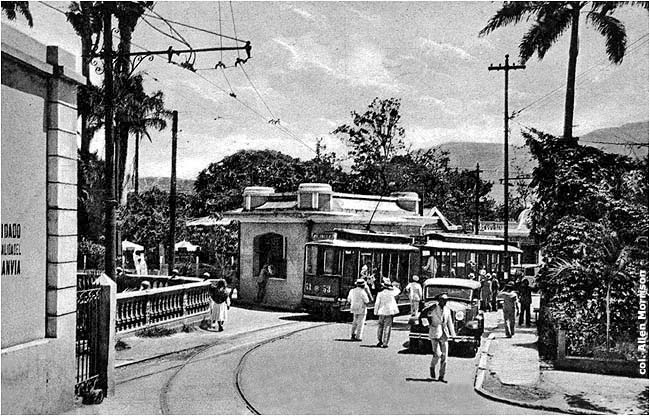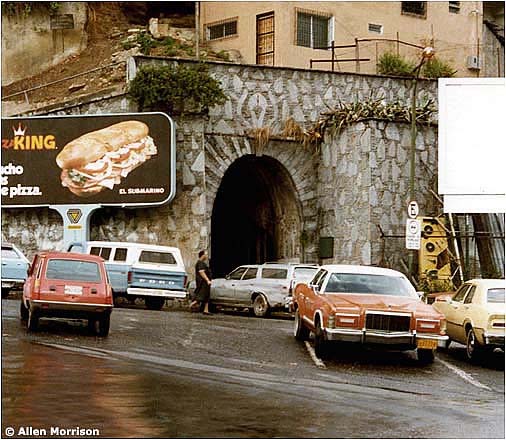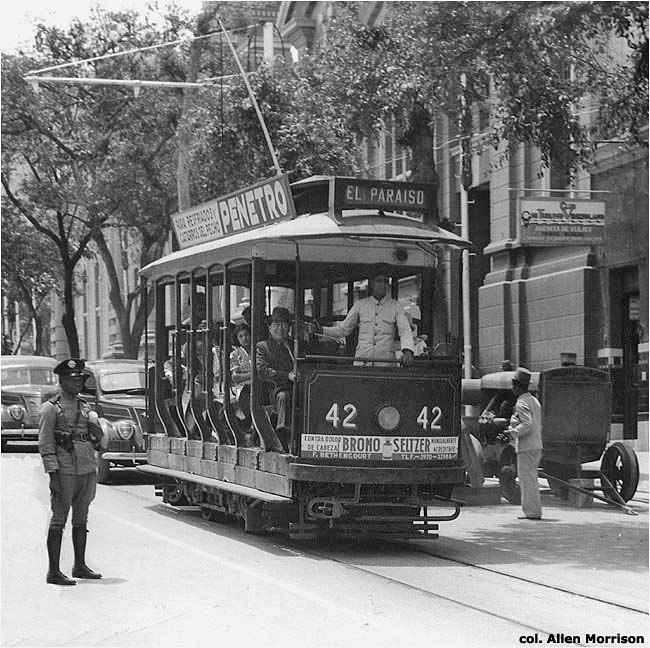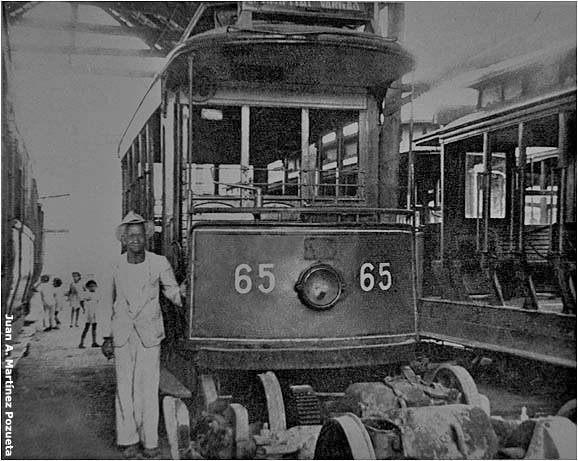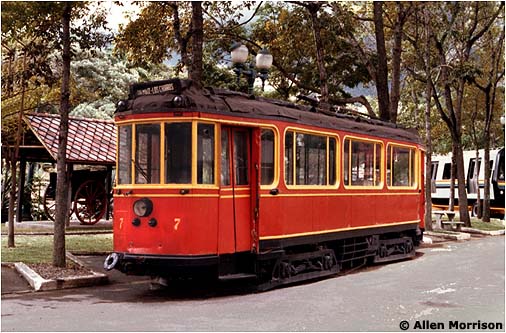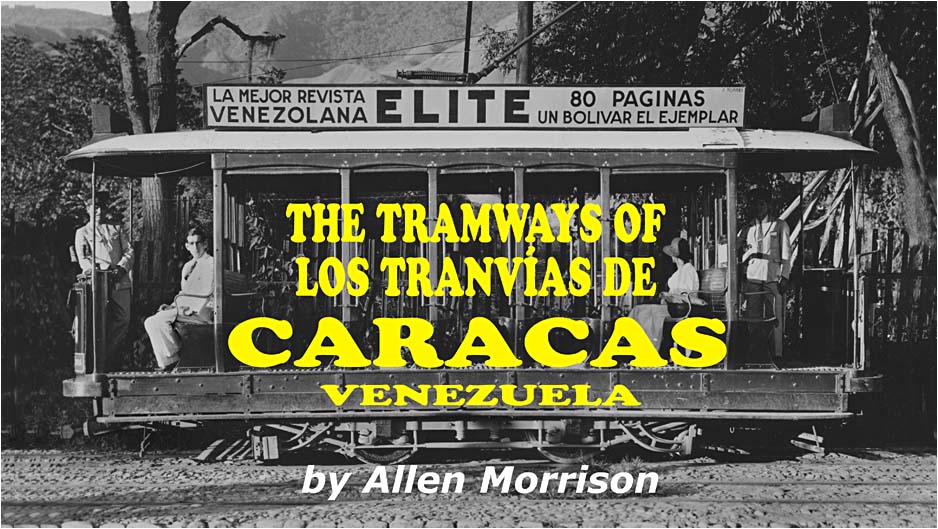
Venezuela had horsedrawn tramways (street railways) in at least a dozen cities. A few places also ran steam locomotives on their streets. Electric trams carried passengers in Caracas, Valencia, Maracaibo, Carúpano, and along the coast between Maiquetía and Macuto. The Ferrocarril La Guaira y Caracas (La Guaira & Caracas Railway) also used tram-like electric cars. All these lines are gone today. This page describes the tramways that operated between 1882 and 1947 in and around the Venezuelan capital. Like Bogotá in Colombia, La Paz in Bolivia and Quito in Ecuador, Caracas lies in a valley high in the Andes that was isolated until the 19th century from much of the western world [see satellite view]. The city's altitude averages 900 m (3,000 ft), but surrounding peaks reach 2,700 m (9,000 ft). Distance from the seaport at La Guaira is only 11 km (8 mi) for a bird, but was 37 km (23 mi) by the winding railway that closed in 1951. Population was about 100,000 in 1900, is around five million today. Caracas had a street railway before it had a steam railroad. The date of its inauguration is uncertain, but most historians agree that Tranvía Caracas was formed as a company in 1881 and began carrying passengers between Plaza Bolívar and Palo Grande in 1882 [see map]. TC extended its line to Puente de Hierro (Iron Bridge) soon after. Another company, Tranvía Bolívar, began operation between Plaza Bolívar and the Ferrocarril La Guaira y Caracas station in 1885. TB extended its tracks eastward to the Ferrocarril Central station in 1886. Both Tranvía Caracas and Tranvía Bolívar used the same track gauge of 750 mm (29.5 in) and both operated vehicles built by John Stephenson Co. in New York. The postcard view below shows a Stephenson car of Tranvía Caracas [col. AM]:
Thirty-one trams were running on Caracas streets by 1891. In 1893 Tranvía Bolívar acquired new equipment from Compagnie La Métallurgique in Nivelles, Belgium. The undated photograph below shows a Belgian car of Tranvía Bolívar at Plaza Bolívar [see map]. The passengers might be company executives and their families [col. AM]:
The area's first steam railroad was Ferrocarril La Guaira y Caracas, which used 914 mm (36 in) gauge and reached the capital in June 1883. Three months later Ferrocarril del Sur (a.k.a. Ferrocarril del Valle) opened a 5-km steam line, track gauge 680 mm (26.8 in), between Las Flores and El Valle [see map]. Ferrocarril Central inaugurated a 10-km steam line between Santa Rosa station and Petare in September 1886 and Gran Ferrocarril de Venezuela opened the first segment of its railroad to Valencia in 1890. The last two companies used 1067 mm (42 in) gauge. Horse trams connected all the railroad stations. Here is a tiny Tranvía Bolívar car at the FLGC station about 1905 [postcard, col. AM]:
Here is another Tranvía Bolívar tram, this time a Stephenson product, at Ferrocarril Central station in the Santa Rosa district [see map] [postcard, col. AM]:
The first electric tramways in Caracas developed in an unusual way. Instead of electrifying its horsecar lines, as was the procedure in most cities, Caracas electrified two of its steam railroads. In the early 1900s Edgar Wallis, E. H. Ludford and Albert Cherry, executives of the English telephone company in Caracas, acquired control of Tranvía Caracas, Tranvía Bolívar, Ferrocarril del Sur and Ferrocarril Central and registered new companies in London. Wallis's new United Electric Tramways of Caracas hired the English firm J. G. White as engineer and ordered four electric trams, numbered 1-4, from John Stephenson Co. in New York. Cherry hired the German firm Allgemeine Elektricitäts Gesellschaft ("AEG") to electrify the Ferrocarril Central. Its first electric cars were electrified steam railway coaches [see Documento 172 of the Ministerio de Obras Públicas]. Electrification of the Ferrocarril del Sur to El Valle and the Ferrocarril Central to Petare began in 1906 [see map]. Perhaps to match the gauge of the Ferrocarril Central, J. G. White chose 1067 mm (42 in) gauge for its new electric tramway system and added a third rail to the El Valle line so that steam operation could continue during reconstruction. Tranvías Eléctricos de Caracas began testing its Stephenson cars in October 1906 and inaugurated the city's first electric tram service, between Las Flores and El Valle, on 15 January 1907 [see newspaper report]. The photograph below was taken at El Valle terminus. Note "T E de C" signs and the three rails to accommodate both 680 (26.8 in) and 1067 (42 in) gauge [col. Carlos Eduardo Misle]:
Ferrocarril Central inaugurated electric tram service between Santa Rosa and Petare the next day, 16 January 1907 [see Documento 172 of the Ministerio de Obras Públicas]. Unfortunately, no pictures of that ceremony could be found. Later in 1907 Tranvías Eléctricos de Caracas ordered 30 more electric trams from Milnes Voss & Co. in Birkenhead, England. Trucks (wheel assemblies) for the cars came from United Electric Co. in Preston, England. Like the Stephenson cars, all were 8-bench models only 7.3 m (24 ft) long and 1.6 m (5.2 ft) wide. The diminutive size of Caracas trams was necessary because of sharp turns in the city's narrow streets. The Milnes Voss trams were numbered 5-34 [col. AM]:
By February 1908 TEC had extended the El Valle line across the Iron Bridge to Plaza Bolívar and electrified all the lines to the railroad stations – including Santa Rosa station, where Ferrocarril Central's electric line began. This photograph shows two of the new Milnes Voss cars at Plaza Bolívar [see map]. The building in the background is the same shown in the second photograph on this page [col. AM] :
Here is a Milnes Voss tram at Ferrocarril Central station [see map]. Compare the fourth photograph above [postcard, col. AM]:
This postcard shows tram 21 crossing the Iron Bridge over the Guaire River [see map]. View is north, toward the city center and the coastal mountains. Las Flores is behind the photographer. The lines on the left (west) side of the pavement are shadows from the fence – not rails! [col. AM]:
The tram shown on this postcard seems to be numbered 2 and is therefore, presumably, a Stephenson model [col. AM]:
This (partially) colored postcard shows a tram numbered 2 that does not seem to be the same vehicle shown in the postcard above. Apparently TEC renumbered some of its vehicles. Car 2 here has the same design as Brill car 41 shown in a photograph below [col. AM]:
An electric tram leaving the Ferrocarril La Guaira y Caracas station [see map], also seen in an earlier view above. That's the Escuela Militar (Military School) atop the hill [postcard, col. AM]:
A newspaper announcement: "Horses for sale. Reduced price for quantity." [El Nacional, Caracas, 14/2/1908]:
TEC constructed its office building and tram sheds on the north side of Av. Este at Av. Vollmer [see map]. Trams went through the gates on the left to reach the depot behind. To the right they continued down Av. Este to Santa Rosa station of the Ferrocarril Central [postcard, col. AM]:
This photograph shows the tram yard and garage behind the office building shown above. The spot is occupied today by one of the city's tallest office towers [Venezuela, Ministerio de Obras Públicas. Revista Técnica, 4/1911]:
In 1909 TEC ordered three 8-bench trams, to be numbered 35-37, from J. G. Brill Co. in Philadelphia. They had the same dimensions and basic design as the Stephenson and Milnes Voss cars purchased earlier [Brill Magazine, Philadelphia, 2/1910, p. 53]:
TEC acquired four more cars from Brill, numbered 38-41, in 1914. Number 41, below, had not yet had its truck attached. Note Brill name and order number in the lower left corner [col. AM]:
A Brill-type car at an unidentified location [col. AM]:
The date, location and circumstances of the view below are unknown. Unless it was renumbered, tram 51 was built about 1915. The scene may be posed, perhaps for a film or advertisement. There are two horses, but there are only five legs. Is the policeman telling the carriage and horses to back up? [col. Glen Beadon]:
The Ferrocarril Central also acquired additional electric cars during this period. Its local tram service helped develop the suburbs east of town and its right-of-way became a grassy strip in the center of Av. Libertador. The 1912 Revista Técnica [see BIBLIOGRAPHY] reported that FC built an electric tram in its shops and imported dos coches para pasajeros (two passenger coaches) from England. It is not clear whether the passenger coaches were intended for its steam railway service, which continued, or were electric trams. RT says that the company operated five carros eléctricos in 1912. In November 1912 Ferrocarril Central opened a new, completely electric 2 km branch off its main line, from Agua de Maíz to Los Dos Caminos [see map]. In 1915, citing the Ferrocarril Guaqui a La Paz in Bolivia as a model, it announced plans to electrify another 17 km of its main line from Petare to Tusmare. That project was never realized, but in May 1917 FC inaugurated a 2 km extension of its branch from Los Dos Caminos to Los Chorros. The photograph below is the only know view of an electric tram of Ferrocarril Central: "Happy times when the tramway was a healthy diversion on Sunday afternoons and took us to Los Chorros". Origin of the 9-bench vehicle is unknown. All TEC cars at that time had eight benches [col. Juan A. Martínez Pozueta]:
Also in 1917, Tranvías Eléctricos de Caracas built a single-track tunnel under Roca Tarpeya hill for its El Valle and Cementerio lines [see map]. Trams traveling south following the original route on the surface, but returned to the city through the tunnel, which was about 1/2 km long. In 1920 TEC ordered three two-axle closed cars from Brill in Philadelphia, to be numbered 61-63 [col. AM]:
Here is an interior view. These seem to have been the first closed trams to run in the city [col. AM]:
This postcard view from the 1920s shows tram 3 again (!), which is signed "Parque de Carabobo" [see map]. The third vehicle in the distance, behind 37, is closed tram 62 [col. AM]
The height of Caracas trams seems to have been three times their width! The car partially visible behind number 12 is another closed model [postcard, col. AM]
The tram above took you to Paradise [see map]. But gasoline buses, which appeared on Caracas streets in the 1920s, got you there faster . . . [col. AM]:
In 1923 TEC built a new line to serve a new residential development called Catia in the western part of town [see map] [col. AM]:
The 1920s was a period of great activity on the city's electric lines. Between 1924 and 1927 TEC purchased four more trams from Brill, a dozen trams from Brush Electrical Engineering in Loughborough, England, and an unknown quantity of motors and trucks from United Electric in England, so that it could build its own vehicles in Venezuela. The pictures below were taken at the Brush factory in England, before attachment of the trucks [col. Robert J. Harley]:
Image quality is poor, but the photo below is the only one found that shows a Brush tram in service in Caracas. The car looks like it might be running on the Petare suburban line [col. Glen Beadon]:
In 1927 Ferrocarril Central purchased two large four-axle doubledeck trams, built by Brush in 1920, from the tramway operator in West Hartlepool, England. Caracas newspapers of the period described a ride to Petare on a doubledecker, but did not supply photographs. In 1927 Ferrocarril La Guaira y Caracas purchased six electric locomotives and four tram-like interurban cars, numbered 31-34, from United Electric in England. FLGC inaugurated electric service on its 37-km mountain line, between La Guaira and Caracas, on 9 April 1928 [see satellite view]. Track gauge was 914 mm (36 in). Passenger car 31 was photographed at Caracas station [La Guaira and Caracas Railway brochure, 1933]:
Since they used the same track gauge of 1067 mm (42 in), Tranvías Eléctricos de Caracas and Ferrocarril Central agreed in 1930 to share their rails. A track connection was made at Santa Rosa and thereafter TEC trams ran over FC tracks to Sabana Grande and FC cars used TEC rails to reach Plaza Bolívar [see map]. Unfortunately, FC's single-track railway could not provide frequent service in the growing suburbs and the line was de-electrified beyond Sabana Grande in 1933. The branch to Los Chorros was abandoned altogether and FC sold its electric cars to TEC. TEC built an experimental trolleybus in 1937, which it liked so much that it built ten more in 1938, all out of gasoline buses purchased new from General Motors. The new electric buses replaced trams on the Catia line, and TEC later built two more trolleybus lines, to San Juan and San Agustín [see map]. [For photographs see the Caracas section of Trolleybus Pioneers.] The
caption on the next postcard says that the picture was taken at
"Esquina Gradillas", which means the corner of Avenidas Norte and Este
2 [col. AM]:
It is not often that one
finds a postcard like the following, especially labeled in two
languages in Latin America. The fact that the tram is signed "San
José" indicates that it was published before 1938, when that
line's "trenvias" were replaced by trolleybuses [col. AM]:
The postcard below, published in Italy [!] in 1937, shows a view north at the portal of the tramway tunnel in Las Flores [see map]. The truncated inscription on the wall reads "CUIDADO SALIDA DEL TRANVIA" (Danger Tramway Exit). Outbound trams such as number 53 will veer left on the track in the foreground, whereas trams arriving from El Valle and El Cementerio will emerge from the tunnel. Cars on the El Paraíso line passed on the other side of the transfer station [col. AM]:
The photograph below was taken at the same spot in 1984, about a half century later. View is south. The wall leading to the tunnel has been removed to make a parking lot. A wire fence has replaced the granite railing [AM]:
A pleasant scene in the late 1930s [col. AM]:
By the 1940s Venezuela was swimming in oil and its capital had grown to enormous size. Gasoline was cheap. Tiny trams running on single track in narrow streets could no longer provide adequate transportation and were replaced, one by one, by gasoline buses and trolleybuses. The proud motorman on tram 37 below looks worried [col. AM]:
The tramway system closed completely on Wednesday 13 August 1947. All the vehicles were scrapped, but rails were left in the streets and some remain there today. The photograph below was taken at the tramway depot on Av. Este shortly after service ended [Juan A. Martínez Pozueta]:
Ferrocarril La Guaira y Caracas closed in 1951. Ferrocarril Central pulled up its rails in 1953 and Gran Ferrocarril de Venezuela stopped running trains to Valencia in 1966. The Ferrocarril Barquisimeto - Puerto Cabello carried passengers from 1959 until 1996. In 1970 the Venezuelan government established the Museo del Transporte in a park east of the city – near where Los Chorros trams had run 37 years before [see map]. Since no trams were preserved in Venezuela, the museum imported two old cars from Europe: 4-wheel number 53 from Zaragoza, Spain, in 1971; and 8-wheel 541 from København, Denmark, in 1972. The latter, renumbered 7, was photographed at the museum in 1984. Its destination box reads "AGUA MAIZ - LOS CHORROS". Note metro train nearby [AM]:
A visitor in 1990 found that both trams had disappeared from the museum. A museum librarian told a visitor in 2007 that the cars were eaten by termites and had been scrapped.
BIBLIOGRAPHY Long, illustrated articles about Tranvías Eléctricos de Caracas in Street Railway Journal (New York), 2/2/1907, p. 204; Electrical Engineer (London), 10/5/1907, p. 666; 9/10/1908, pp. 524-526; and 16/10/1908, pp. 554-555; Electric Railway Journal (New York), 24/10/1908, pp. 1242-1244; Electrical World (New York), 31/10/1908, pp. 941-942; Tramway & Railway World (London), 5/11/1908, pp. 389-393. "La Apendicitis y los Tranvías" in El Cojo Ilustrado (Caracas), 15/2/1908, p. 131. The belief that vibrations from passing trams can cause appendicitis . . . "Tranvías Eléctricos de Caracas" in El Cojo Ilustrado (Caracas), 1/7/1908, p. 399. A brief corporate history. Illustrated articles about the electrification and operation of the Ferrocarril Central in publications of the Ministerio de Obras Públicas: Memoria, 1909, pp. 215-216; Memoria, 1915, pp. cxvi-cxvii; Memoria, 1917, p. 360; Memoria, 1918, v. 2, Documentos 345-349 (Los Chorros line); Memoria, 1927, v. 1, p. 206 (doubledeck trams); Memoria, 1929, pp. 105-106; Memoria, 1931, v. 2, pp. 482-483; Revista Técnica, 11/1911, pp. 521-522; and 1/1914, pp. 8-11 (Los Dos Caminos). Caracas tramcars described in Brill Magazine (Philadelphia), 2/1910, p. 53; and 8/1925, p. 313. "Industrias Nacionales: Tranvías Eléctricos de Caracas" in Revista Técnica del Ministerio de Obras Públicas, 4/1911, pp. 197-202 and illustrated supplement. Good description and pictures of the city's new tramway system. Also see article below. "Los Circuitos Eléctricos de Caracas" in Revista Técnica del Ministerio de Obras Públicas, 11/1911, pp. 545-549. The article, dated 10/1906, describes problems created by the new electric trams testing on the Ferrocarril Central and Ferrocarril del Sur (El Valle line). Inventory of electric equipment in 1906. Lucas Manzano. Album Gráfico del Distrito Federal. Caracas, n.d. [1916]. Nice photos of early tramway construction. "Railway Builds Tunnel to Reduce Grade" in Electric Railway Journal (New York), 21/4/1917, p. 737. Construction of the Roca Tarpeya tramway tunnel. Venezuela. Ministerio de Obras Públicas."Ferrocarril Central de Venezuela: Itinerario de los Carros Eléctricos" in Los Ferrocarriles de Venezuela, pp. 122-123. Caracas, 1920. Electric tram schedules on the Ferrocarril Central. U.S. Bureau of Foreign and Domestic Commerce. Trade Promotion Series no. 39: "Railways of South America". Washington, 1927. "Venezuela Central Railway Co. (Ltd.)", pp. 357-358, describes operations, shows map of line. Ricardo Razetti. Plano de Caracas. Caracas, 1929. Excellent map at scale 1:10,000 shows streetcar lines (including Roca Tarpeya tram tunnel). Guía Comercial y Administrativa de Caracas. Caracas, 1933. "Plano Esquemático de Caracas" shows routes of 11 tram lines and 16 bus lines. U.S. Bureau of Foreign and Domestic Commerce. World Survey of Foreign Railways. Washington, 1933. Name, finances, kilometrage, gauge and fleet statistics of the tramways of Venezuela. Venezuela. Ministerio de Fomento. Dirección General de Estadística. Anuario Estadístico. The editions for 1937 through 1946 note tramway data in Caracas and Valencia. (The Anuario was not published before 1937 and did not provide tramway information after 1946.) Fred Lavis. F. C. Central, Distrito federal y estado Miranda, Estados Unidos de Venezuela: Informe. Report of an investigation made at the request of the Ministerio de Obras Públicas of Venezuela. New York, 1939. "Replacement of Caracas Tramways - Adoption of Simplified Trolleybuses - Petrol Chassis with Tramcar Equipment" in Modern Transport (London), 22/6/1940, pp. 11-12. The construction and operation of the city's 11 trolleybuses. Lucas Manzano. "Los Tranvías de Caballos" in Billiken (Caracas), 1944, n. 970. Detailed 4-page description of early horsecar operations. Aquiles Nazoa. Caracas física y espiritual. Caracas, 1947. "Pequeña historia de los vehículos," p. 61 ff, considers both animal and electric cars. Juan A. Martínez Pozueta. "Soliloquio de un tranvía" in Revista Shell (Caracas), 6/1958, pp. 77-80. Memories of a Caracas tram, written in the first person. Charming. Illustrated. Francisco Pimentel. Obras Completas. Mexico City, 1959. Fifteen poems about Caracas trams, pp. 334-342: "El Tranvía de Catia", "El Tranvía de La Pastora", etc. Evolución del Transporte en Venezuela: Edición conmemorativa de la creación del Museo del Transporte. Caracas, 1970. A 145-page survey of transportation in Venezuela. Extensive discussion and many pictures of trams on pages 21-25 and 90-103. Carlos Eduardo Misle ('Caremis'). "Hace 70 Años Caracas Tuvo Tranvías" in El Nacional (Caracas), 18/12/1978, pp. D1 and D27. Long, illustrated history. Luis Cordero Velásquez. La Venezuela del Viejo Ferrocarril. Caracas, 1990. Impressive, 40-chapter, 289-page illustrated survey of railway development, with unusual emphasis on tramways. A paragraph in Tramway Review (London), Spring 1992, p. 168, describes West Hartlepool trams 29 and 32 shipped to Venezuela. Alfredo Schael and Enrique Martín C. Transportes en Venezuela: Volumen II. Caracas, 1997. A 40-page history of transportation issued by the Museo del Transporte. The chapter "Tranvías sin dejar huella", pp. 16-17, acknowledges that no trams were preserved in Venezuela. "Recuperado antiguo túnel del tranvía" in El Universal (Caracas), 19/5/1997. Renovation of the abandoned tramway tunnel. José Jacobi. Los Tranvías de Caracas. Nice webpage with brief history and seven pictures of the electric tramway system. In addition to Sr. Marcelo Madariaga of Chile who kindly provided the Spanish translation, the author would like to thank the following persons for their assistance in the preparation of this page: Gerardo Sánchez Torres, Haridas Mederos Ocando and Carlos Eduardo Misle in Venezuela; Antônio Miranda in Brasil; Emídio Gardé in Portugal; José María Valero in Spain; Roy Toralf Budmiger in Norway; Allan De Koningh in the Netherlands; Roland Dussart Desart in Belgium; Robert J. Harley in England; and Harold E. Cox and William J. Rossman in the United States.
See The Tramways of Macuto, La Guaira & Maiquetía See The Trolleybuses of Mérida See my index of If you have comments, criticism or suggestions, This site was placed online on Copyright © 2007-2107 Allen Morrison |

